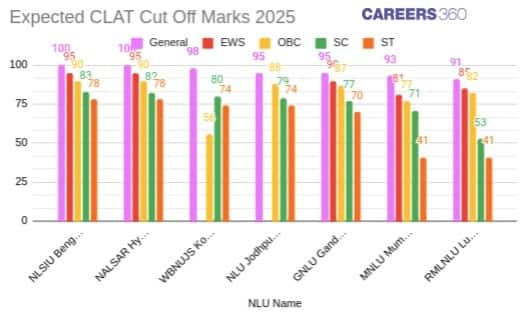Amity University-Noida Law Admissions 2026
Among top 100 Universities Globally in the Times Higher Education (THE) Interdisciplinary Science Rankings 2026
Only those candidates who clear the CLAT cut-off 2025 will be offered admissions. But how high will the CLAT 2025 cut-offs go? Last year, the CLAT 2025 exam pattern was revised to make the Common Law Admission Test more student-friendly. As a result, the CLAT cut-offs were high. Read on to find out how high the CLAT cut-off 2025 is likely to be including the expected good score in CLAT and category-wise cut-off. CLAT 2025 is on December 1, 2024.
CLAT 2026 cut-offs for the top NLU’s, as per previous year’s trends, are as follows.
Top NLUs | Expected cut-off marks | UG seats offered, excluding supernumerary NRI seats |
NLSIU Bengaluru | 100+ | 300 |
NALSAR Hyderabad | 100+ | 132 |
WBNUJS Kolkata | 98+ | 108 |
NLU Jodhpur | 95+ | 164 |
GNLU Gandhinagar | 95+ | 172 |
This Story also Contains

How high the cut-off for CLAT 2025 will go will depend on the factors given below:
Difficulty level: A more difficult exam will mean, the CLAT cut-off 2025 will not be too high. A good score in CLAT 2025 will be lower if the exam turns out to be difficult. A revised CLAT pattern has driven the CLAT cut-off higher, close to 80% marks for the general category, than the earlier 64-66%.
Number of applicants: Around 75000+ candidates have registered for CLAT 2025. A higher number of applicants usually translates to tougher competition which will in turn drive the CLAT cut-off 2025 higher.
Available Seats: If the number of seats is higher then more students can be given admission. For instance, NLSIU Bengaluru now offers more than 100 seats which has resulted in the NLU cut-off getting lower.
NLU Preferences: Another factor determining how high the CLAT cut-off 2025 will go is the NLU preferences submitted by candidates. If more candidates opt for a particular NLU, the cut offs will be higher. If there are plenty of NLU vacant seats as happens with certain lower-ranked NLUs, then the NLU cut-off 2025 will be lower
Reservation Criteria: The NLU admission will be done as per the CLAT reservation criteria followed by each NLU. The CLAT cut-off for the general category is often the highest among all categories. However, how high the cut-off will go will also be affected by factors such as domicile reservation, horizontal reservation for women, and vertical reservation for SC, ST, and OBC categories.
Among top 100 Universities Globally in the Times Higher Education (THE) Interdisciplinary Science Rankings 2026
Ranked #18 amongst Institutions in India by NIRF | Ranked #1 in India for Academic Reputation by QS Rankings | 16 LPA Highest CTC
As per the trends observed last year, the CLAT 2025 cut-off marks are expected to be high. Candidates have to score in the range of 80 to 85% marks to get a seat in the top NLUs. However, the CLAT cut-off ranks at top NLUs are expected to remain the same.
Category | NLSIU Bengaluru | NALSAR Hyderabad | WBNJUS Kolkata | NLU Jodhpur | GNLU Gandhinagar | MNLU Mumbai | RMNLU Lucknow |
100 | 150 | 250 | 350 | 450 | 600 | 750 | |
500 | 550 | - | - | 1200 | 3900* | 2300* | |
950 | 1100 | 23000* | 1400 | 1850 | 6400* | 3600* | |
3000 | 3500 | 4500 | 5000 | 6000 | 10000* | 25000* | |
6000 | 6000 | 8000 | 8000 | 11000 | 34000* | 34000* | |
- | - | 1250 | 1400 | 2800 | 33000 | 9500 |
*state category reservation

The table given below provides the CLAT 2025 marks vs rank analysis detailing what ranks the marks in CLAT 2025 will translate into. As per last year’s trends candidates needed to secure around 80% marks to clear the cut off for top NLUs.
CLAT 2025 marks | Expected CLAT 2025 rank |
98+ marks | 200 or higher |
92+ | 500 or higher |
90+ | 1000 or higher |
88+ | 1500 or higher |
86+ | 2000 or higher |
85+ | 2500 or higher |
83+ | 3000 or higher |
82+ | 3500 or higher |
80+ | 5000 or higher |
77+ | 6000 or higher |
74+ | 8000 or higher |
72+ | 10000 or higher |
Frequently Asked Questions (FAQs)
CLAT 2025 results will be declared tentatively in the second week of December.
A good score in CLAT 2025 is expected to be around 95-100+ marks for general categories.
CLAT 2025 cut-off can be downloaded from the merit list of CLAT 2025 published for each round of counselling.
On Question asked by student community
Hello aspirant,
The Gujarat domicile rank is useful only for seats reserved under the domicile quota at GNLU Gandhinagar. However, even for domicile candidates, GNLU cutoffs usually close at much better All India Ranks. With an AIR of 19000, the chances are quite low, but since counselling invitation is received, it is still worth participating as some movement can happen in later rounds. Do not rely only on domicile rank final allotment depends on AIR, category and seat availability.
FOR REFERENCE : https://law.careers360.com/articles/gnlu-gandhinagar-admission
Hope the details will help you.
THANK YOU
Hello,
Based on previous year CLAT cutoff trends , your chances for NLSIU Bangalore are very low .
NLSIU Bangalore has the highest cutoff among all NLUs . In recent years, the final closing rank for General category has been around AIR 100–120 only.
You have:
General category AIR: 658
Women category rank: 313
No Karnataka domicile
Women reservation in NLUs is horizontal , not a separate quota. This means it does not add extra seats . It only helps when candidates are very close to the general cutoff. At a rank of 313 , the gap is too large.
Even in spot or final rounds, NLSIU does not go beyond ~120 rank for General category candidates without domicile.
However, with these ranks, you have good chances in other top NLUs like NALSAR Hyderabad, WBNUJS Kolkata, NLU Jodhpur, GNLU Gandhinagar, and NLIU Bhopal, depending on counselling rounds.
You can also use our CLAT College Predictor Tool to predict which colleges you can get based on your score and rank.
Hope it helps !
Good afternoon,
With 86.7 marks and 1906 rank in CLAT 2026, you have a chance to get admission in mid-tier and the newest NLUs. The list of probable NLUs where you can get admission is mentioned below.
1. RMLNLU Lucknow
2. MNLU Mumbai
3. DSNLU Visakhapatnam
4. NLU Odisha
5. CNLU Patna
Thank you.
Hello,
Yes, a student with CLAT 2026 rank around 12,000 can register for counselling.
However, chances of getting a seat in the top NLUs (like NLSIU Bangalore, NALSAR Hyderabad, WBNUJS Kolkata, NLIU Bhopal) are very low, as their closing ranks are usually below 4,000 for the general category.
For mid-tier NLUs (like NLU Jodhpur, HNLU Raipur, GNLU Gandhinagar, RMLNLU Lucknow), closing ranks generally go up to 5,000–8,000, so it will still be difficult.
Lower-tier NLUs (like NLU Odisha, NUALS Kochi, NUSRL Ranchi, NLUJA Assam, DSNLU Vizag, TNNLU, HPNLU Shimla) sometimes admit candidates with ranks in the 10,000–30,000 range , especially in later counselling rounds or if there are vacancies. State quota reservations can also improve chances.
You can also use our CLAT College Predictor Tool to predict which colleges you can get based on your score and rank.
Hope it helps !
Hello,
A CLAT score of 81.25 places you in the moderate range, where admission to top NLUs becomes difficult, but opportunities may still remain in newer and mid-tier NLUs, depending on your category, seat movement, and round wise cutoffs.
https://law.careers360.com/articles/clat-2026-college-predictor
Hope you understand.
Among top 100 Universities Globally in the Times Higher Education (THE) Interdisciplinary Science Rankings 2026
Ranked #18 amongst Institutions in India by NIRF | Ranked #1 in India for Academic Reputation by QS Rankings | 16 LPA Highest CTC
AICTE & UGC Approved | NAAC A+ Accredited
NAAC A++ Approved | Curriculum Aligned with BCI & UGC
India's Largest University | BCI approved | Meritorious Scholarships up to 5 lacs |
Integrated Learning – A balanced blend of management and legal education